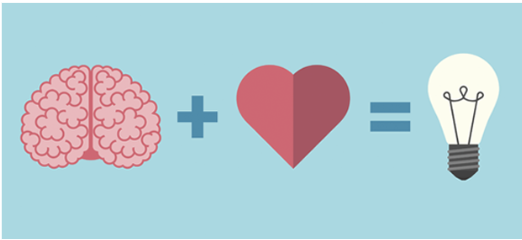We need people in our workplace who can connect with others, who display empathy and understanding, (and) who understand emotions. More than ever, emotional intelligence is not just a ‘nice to have but a core capability for the future.’’
-Pip Russell, Strategy, innovation, and commercial operations vice-president, Schneider Electric (Capgemini, 2022)
Intelligence is what helps us learn, process, adapt, and grow, and there are various types of it. There’s an emerging type, equally if not more important: Emotional Intelligence (EI).
World Economic Forum’s The Future of Jobs Report 2020 highlights EI at 11th in the list of top 15 skills for 2025, describes it as ‘Developed capacities used to work with people to achieve goals and in particular being pleasant, cooperative, sensitive to others, easy to get along with and enjoying work with people’ (The Future of Jobs Report 2020, n.d.). Capgemini Research Institute reported that the demand for EI is to rise by six times globally, highest in India at 8.3 times across sectors, and highest for the financial sector, because of more routine tasks being increasingly automated, and EI is something that Artificial Intelligence (AI) struggles recreating. 74% of employers/executives and 58% of non-supervisory employees believe it to be highly crucial and necessary intelligence in the coming years. However, less than one in five organizations offer EI training (Capgemini, 2022).
Mayer and Salovey (1993) were the first to coin and define emotional intelligence: as a type of social intelligence that involves the ability to monitor one’s own and others’ emotions… (Salovey & Mayer, 1990)…includes the verbal and nonverbal appraisal and expression of emotion, the regulation of emotion in the self and others, and the utilization of emotional content in problem-solving. Meanwhile, Sternberg’s contextual sub theory/practical intelligence (PI) is interlinked with one’s environment and helps decide whether to choose, adapt to, and/or shape the environment. In the context of workplaces, PI is about how the organization and individual work together so that it can help adapt the individual to its culture and needs while allowing them to shape it positively to foster inclusivity and best use their abilities, experience some level of freedom to get the tasks done, and not just bring out and maximize their abilities, but be an attractive, positive workplace that can help organizations recruit the best; And EI is about how the employee feels and relates to the organization, workplace, their co-workers, vice versa, and how do they manage their emotions, relationships and increase their chances of thriving collaboratively.
Highly EI people are better ‘adept at behaving in successful ways in their external environment’ (Vinney, 2020). Higher levels of both could help an employee adapt and shape the workplace for the better, make better-informed choices about the workplace they’d work at, and even create a workplace that focuses on bringing the best out of its employees. EI is linked to reduced chances of aggressive behavior (García-Sancho et al., 2014), healthier relationships (Lopes et al., 2003) and increased motivation leads to greater productivity, work-life satisfaction, creativity, in turn, greater innovations and success of both the employee and employer (Yang et al., 2021). It helps with building resilience (Magnano et al., 2016) which can be a vital ability to bounce back from challenging times, be it in personal and/or work lives, and keep them motivated. Reduces burnout rates that affect well-being.
EI helps in developing empathy for each other, emotionally and intellectually (opinions, ideas), and aids in managing and preventing conflicts, and better dealing with high-pressure/stressful events. In a globalized world, be it a physical or virtual workspace, the workforce is diverse in terms of age, gender, sexuality, caste, race, ethnicity, culture, religion, disability, neurodivergence, etc. Hence empathy becomes particularly important for a healthy relationship among employees, with supervisors/managers, and to accept each other as equals, and learn to offer constructive criticism, disagree assertively, and work collaboratively to create an inclusive, innovative environment. EI and PI can help in building a positive attitude toward the organization, and build their leadership skills, and employees with higher EI naturally take up leadership positions in leaderless spaces, and conversations (Njoroge & Yazdanifard, 2014) (Hong et al., 2011).
The same Capgemini report shows that organizations experienced over 60% increase in productivity, employee satisfaction, and market share, while employees experienced around a 50% increase in openness, better emotional and mental well-being, and reduced fear of job loss. It recommends using data & tech, along with updating current programs, rewarding and promoting with EI in mind, and making it part of the recruitment process, and another study even suggested considering a higher EI but low traditional intelligence candidate for a position in the service industry as people skills are vital.
Time for businesses to invest in emotions more!
References
Aqqad, N. O., Obeidat, B. Y., Tarhini, A., & Masa’deh, R. (2019). The relationship among emotional intelligence, conflict management styles, and job performance in Jordanian banks. International Journal of Human Resources Development and Management, 19(3), 225. https://doi.org/10.1504/ijhrdm.2019.100636
Capgemini. (2022, August 25). Emotional Intelligence | Research & insight | Capgemini. Retrieved March 12, 2023, from https://www.capgemini.com/insights/research library/emotional-intelligence/
García-Sancho, E., Salguero, J. M., & Fernández-Berrocal, P. (2014). Relationship between emotional intelligence and aggression: A systematic review. Aggression and Violent Behavior, 19(5), 584–591. https://doi.org/10.1016/j.avb.2014.07.007
Gong, Z., Chen, Y., & Wang, Y. (2019). The Influence of Emotional Intelligence on Job Burnout and Job Performance: Mediating Effect of Psychological Capital. Frontiers in Psychology, 10. https://doi.org/10.3389/fpsyg.2019.02707
Hong, Y., Catano, V. M., & Liao, H. (2011). Leader emergence: the role of emotional intelligence and motivation to lead. Leadership & Organization Development Journal, 32(4), 320–343. https://doi.org/10.1108/01437731111134625
Lopes, P. S., Salovey, P., & Straus, R. S. (2003). Emotional intelligence, personality, and the perceived quality of social relationships. Personality and Individual Differences, 35(3), 641–658. https://doi.org/10.1016/s0191-8869(02)00242-8
Magnano, P., Craparo, G., & Paolillo, A. (2016). Resilience and emotional intelligence: which role in achievement motivation. International Journal of Psychological Research, 9(1), 9–20. https://doi.org/10.21500/20112084.2096
Mayer, J. E., & Salovey, P. (1993). The intelligence of emotional intelligence. Intelligence, 17(4), 433–442. https://doi.org/10.1016/0160-2896(93)90010-3
Nguyen, N. H., Nham, P. T., & Takahashi, Y. (2019). Relationship between Ability-Based Emotional Intelligence, Cognitive Intelligence, and Job Performance. Sustainability, 11(8), 2299. https://doi.org/10.3390/su11082299
Njoroge, C., & Yazdanifard, R. (2014). The Impact of Social and Emotional Intelligence on Employee Motivation in a Multigenerational Workplace. Global Journal of
Management and Business Research, 14(3).
https://globaljournals.org/GJMBR_Volume14/5-The-Impact-of-Social-and Emotional-Intelligence.pdf
Se, C. (2019, October 17). Demand for emotional intelligence skills soars six-fold in response to the rise of AI and automation. GlobeNewswire News Room.
https://www.globenewswire.com/news-release/2019/10/17/1930966/0/en/Demand for-emotional-intelligence-skills-soars-six-fold-in-response-to-the-rise-of-AI-and automation.html#:~:text=While%20demand%20for%20EI%20skills,lower%20attritio n%20and%20cost%20reductions.
Sternberg, R. J. (1999). The Theory of Successful Intelligence. Review of General Psychology, 3(4), 292–316. https://doi.org/10.1037/1089-2680.3.4.292
The Future of Jobs Report 2020. (n.d.). World Economic Forum.
https://www.weforum.org/reports/the-future-of-jobs-report-2020/in-full Vinney, C. (2020, January 19). Understanding the Triarchic Theory of Intelligence. ThoughtCo. https://www.thoughtco.com/triarchic-theory-of-intelligence-4172497 What is Emotional Intelligence? 2 Theories and Measures. (2019, July 4). PositivePsychology.org.uk. http://positivepsychology.org.uk/emotional-intelligence mayer-salovey-theory/
Why empathy is good for business – and how to improve it. (2020, November 10). World Economic Forum. https://www.weforum.org/agenda/2020/11/companies-can-learn empathy-here’s-why-they-should/
Yang, R., García-Díaz, V., & Hsu, C. (2021). Use of emotional intelligence to promote innovation among employees in the work environment through qualitative and quantitative analysis. Aggression and Violent Behavior, 101589. https://doi.org/10.1016/j.avb.2021.101589
About the author


